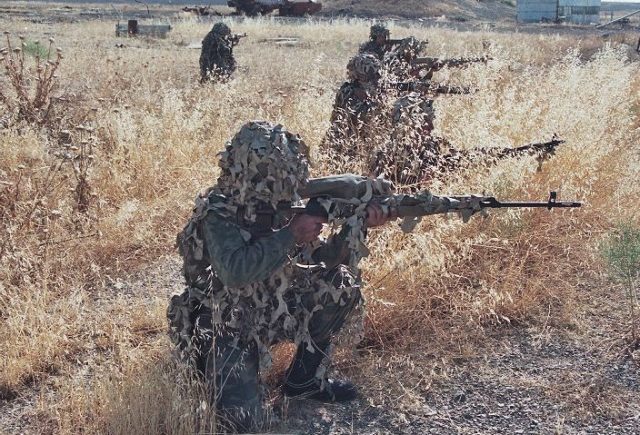
Armenia and Georgia Hold Joint Exercise With NATO Soldiers
Publication: Eurasia Daily Monitor Volume: 14 Issue: 14
By:

For the past several weeks, a group of Armenian soldiers have been taking part in a joint exercise with their Georgian counterparts at the Sachkhere Mountain Training School—a training facility in Georgia established with assistance from the United States and France. Since 2010, the school has been a North Atlantic Treaty Organization (NATO) Partnership for Peace (PfP) Training and Education Center. The joint exercise began on January 16 and will end on February 10. It includes training at a shooting range on mountainous terrain, as well as skiing, construction of shelters, and rescue operations in case of avalanches. Fourteen NATO servicemen (French and Lithuanians) are participating in the exercise beside the Armenian and Georgian personnel (News.am, January 16).
Armenian Deputy Defense Minister Davit Tonoyan mentioned cooperation with Georgia already in 2015, saying that non-commissioned officers (NCO) of the Armenian army trained at Sachkhere, while officers of the Georgian army and public servants took part in courses at the American University of Armenia, in Yerevan. He also said that Armenian-Georgian military cooperation would focus on peacekeeping; and the two countries’ military units participating in international peacekeeping operations have a similar level of readiness, both having passed a relevant assessment process pursuant to NATO’s Operational Capabilities Concept (Mediamax.am, July 27, 2015). The two countries’ bilateral military cooperation is regulated by agreements renewed annually. An agreement signed in December 2016, in Tbilisi, by Armenian and Georgian ministers of defense, Vigen Sargsyan and Levan Izoria, respectively, provides for further cooperation in military planning, education and medical assistance (Armeniasputnik.am, December 21, 2016).
While bilateral cooperation, as well as cooperation within the wider PfP framework, is mutually agreeable and beneficial, a wider scope of cooperation is essentially limited by Armenia’s dependence on Russia—not only in the military sphere, but also increasingly politically. The level of that dependence suggests that Armenia’s cooperation with NATO as well as with other Western institutions strongly depends on Russia’s permission and whether Moscow regards any cooperation framework as a threat to its interests. Furthermore, Russia’s own relations with the West may influence its decisions vis-à-vis Armenia at any moment. Because of this, it remains unclear whether a new framework agreement between Armenia and the European Union will ultimately be signed. Although Deputy Foreign Minister Karen Nazaryan said, last November, that the agreement would likely be signed in spring 2017 (Azatutyun.am, November 3, 2016), it is still not certain if this will actually happen; and some local observers are quite skeptical. Thus, the head of the Yerevan-based Analytical Center on Globalization and Regional Cooperation, Stepan Grigoryan, noted that Russia’s pressure could be the only cause preventing Armenia from signing the agreement and that Russia may block the agreement at any time, up until the moment of signing (Tert.am, January 17).
Meanwhile, concern is growing about the possibility of rising tensions in the South Caucasus eventually leading to open conflict. Georgian analyst Gela Vasadze has suggested that as long as the presidential administration in the United States lacks clear foreign policy priorities, Russia has a “window of opportunity” during which it can boost its capacities in the region. Vasadze criticized the Georgian government for a recent reduction of the military by 2,250 personnel and for the speculations about a possible cut in the number of Georgian tanks and artillery systems (Krym Realii, February 3). David Shahnazaryan, the lead analyst of the Yerevan-based Regional Studies Center, has also suggested that unassertive or possibly even accommodating policies by the United States and the European Union leave Russia with the opportunity to attempt to pursue a more aggressive “post-Soviet integration” policy and, in particular, to try to subdue the entire South Caucasus (A1Plus.am, February 3).
In recent months, Moscow has continued to take steps to increase its military capacity in the region. Following the Russo-Armenian treaty on joint air defense, signed on June 30, 2016, Russia deployed a Nebo-M radar system to Armenia. According to Russian military analyst Yevgeny Damantsev, this radar system will allow Russia to hamper NATO and Israeli air force operations in the Middle East. In addition, this deployment reflects Moscow’s belief in “the growing military threat from Georgia”—i.e. a purported plan to deploy NATO infantry units and Patriot PAC-3 or SAMP/T surface-to-air missiles to Vaziani, just outside Tbilisi (Rosbalt.ru, January 27). The new Russian deployment supplements Moscow’s growing military presence recently manifested by the establishment of a joint Russo-Armenian military unit (see EDM, November 30, 2016). Additionally, Russian troops deployed in Armenia and in occupied Abkhazia and South Ossetia have been engaged in intensive exercises (see EDM, February 1). At the same time, Russia has been able to strengthen its position as a key energy player in the region (see EDM, January 19).
The fears of growing Russian domination of or even potential aggression toward the South Caucasus are further aggravated by the Kremlin’s policy of distracting Russia’s population from domestic challenges by nurturing anti-Western grievances and a fortress-under-siege mentality. That policy has led to a situation whereby the Russian regime’s internal stability depends on ever more belligerent propaganda, while Moscow’s options for breaking Russia’s international isolation are essentially limited to subversive actions against the West and Western-oriented post-Soviet countries. A failure to advance its goals by means of current fighting in eastern Ukraine may become an additional stimulus for the Kremlin to change its focus, even if temporarily, to the South Caucasus—with unpredictable consequences for the countries of this tense region.



